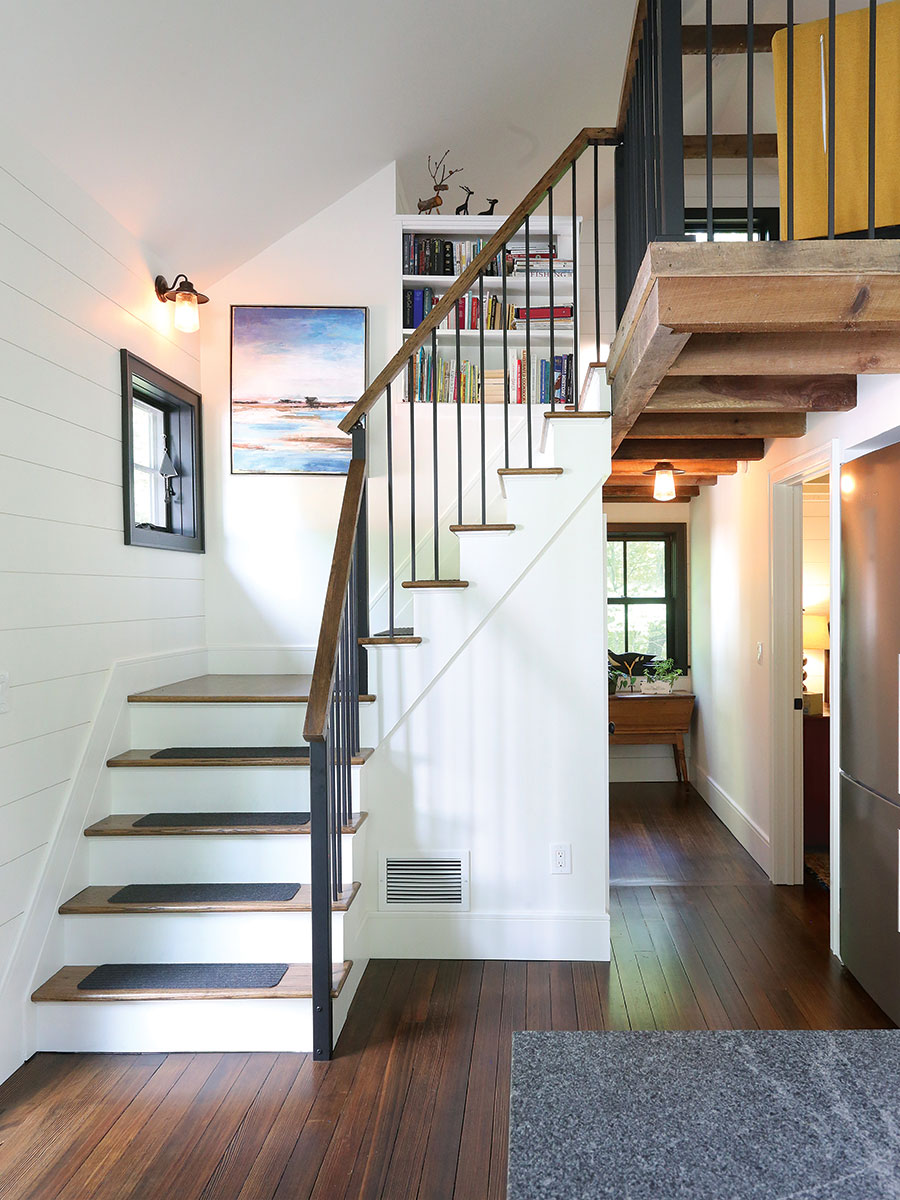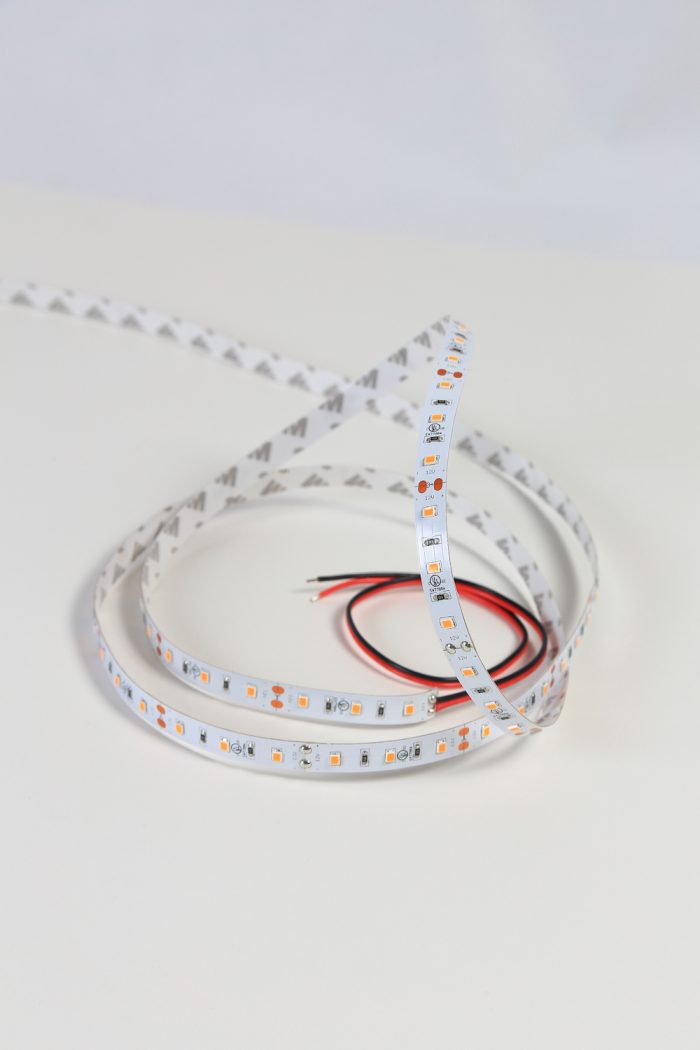Illuminating an Indoor Staircase
Consider code, practicality, and aesthetics when lighting interior stairways.

While there are practical reasons for making sure an indoor staircase is illuminated, the type of lights you use can also add visual appeal and turn a utilitarian set of stairs into a feature. While the code requires a certain amount of illumination, much of the decision is based on personal preference—whether that be a traditional chandelier over a grand staircase, modern LED strips on the treads, or simple overhead utility light.
In this article, we’ll go over stair-design basics, how much light you’ll need per code, types of lighting sources, and other safety and code requirements for illuminating your stairs.
While stairs are the least-used spaces in homes in terms of time spent, they are often crucial parts of a house’s architectural features. In addition to safe and adequate lighting that’s appropriately located and controlled, there are a few other characteristics any stair composed of at least three steps should have:
- Reachable and continuously graspable handrails that are structurally stable (on one side or both), with intermediate handrails as required
- Properly proportioned risers and treads with close tolerances
- Slip-resistant treads and nosings
- Guards (and toe boards on steps if open on the side)
You’ll find stairs in straight runs, curved or split runs with landings, and even spiral staircases. All designs need proper illumination per code.
To simplify things, you can decide on closed or open-riser stairs. Closed-riser stairs, which are also known as “closed-tread stairs” or “box stairs,” prevent you from seeing between the steps. In contrast, open-riser stairs take away the small solid vertical board in between each step, giving the staircase a more open feel.
Wood, closed-tread stairs are considered a more traditional design and they’re inherently safer for pets and children (who might fall through an open riser). Open riser stairs are a popular choice in homes with more modern aesthetics, and you’ll find them in a number of different materials beyond wood, including combinations with steel and glass.
Code compliance and safety with staircase lighting
Safety is the number one priority when considering how to light a staircase. A 2017 study by The American Journal of Emergency Medicine found that there is on average each year over one million injuries related to falling down stairs.

The International Residential Code (IRC) requires in section R303.7 that interior stairways have lighting that illuminates the landings and treads. The code also specifically states that the light should be able to illuminate treads and landings to levels of at least 1 foot-candle (approx. 11 lux) measured at the center of treads and landings.
Lighting manufacturer J.W. Speaker breaks down those two measurements simply. Foot-candles and lux both measure the amount of visible light that falls on a surface. The difference is that a foot-candle uses the imperial system, while lux uses the metric system. So a single foot-candle is able to light up a 1-sq.-ft. surface area from 1 ft. away. One lux is able to light up a 1-sq.-meter surface area from one meter away.
To put the code in layman’s terms, that means you need a light near the first stair and the last stair, or a light over the middle of the stairs that illuminates the entire run.
Additionally, the code says that a wall switch should be at each floor level to control the light if the stairway has six or more risers. An exception to this is when you have a remote, central, or automatic control for the light.
Codes are hyper-local, so it’s best to double-check requirements for the specific region you’ll be designing and building in as well.
How to decide on the amount of light you’ll need
The most critical factors when determining staircase lighting are considering who will be using the stairs and when they’ll be using the stairs, according to lighting expert David Warfel.
Our eye lenses discolor as we grow older, which diminishes the daylight that will come through them. Somebody who is 55 years old isn’t getting as much daylight as some in their 20s.
“The older the person, the more lighting you’re going to need,” Warfel said in an interview. “The research on the intersection of light and wellness, especially regarding light and sleep, means that if you’re going up the stairs at nighttime to bed, you just want enough light to be safe, but no more than that.”
Additionally, color temperature is a key factor as well. Anything in between 2700 and 3000 kelvin (K) is ideal throughout your home.
“Most people aren’t going to set a dimmer in a staircase,” Warfel said, “because we’re only in that staircase for a little bit. We typically use some sort of step light or low-level lighting below the horizon line for safety and comfort at nighttime.”
With open floor plans, stairs are often visible all day long from the living room or another area of the house, and that’s where adding chandeliers or lights underneath the edges of your steps can actually benefit the homeowner in terms of comfort all day long, despite only going up and down the stairs a handful of times.
Methods of lighting
There are many ways to light up a staircase indoors, and mixing two layers of lights is ideal: one for when you need full illumination going up and down the stairs, and one for when you just want the bare minimum.

Chandeliers, or any pendant or spot lights coming from the ceiling, are a good first source of lighting for all-around illumination. If you do need to frequently go up and down the stairs at night, a constant, bright light source is key.
For that second layer of light, recessed step lighting, which is lighting on a wall that shines down on the steps, has an edge over other methods because of the ease of installation. These lights mount to a standard receptacle box. Warfel says this is by far the most popular choice for his clients. Recessed down lights should be integrated LED engines, which only require an input voltage, and not screw-in bulbs or pop-in trims. Pricing can range anywhere from $30 to over $150 per light, depending on the brand you choose and the amount of wattage you desire.
LED strips are also growing in popularity for both practical and aesthetic purposes. LED strips function like a strand of Christmas lights, but without bulky wiring. Strips can be installed on each step—below individual treads, along the side of each tread, in the middle of the individual steps, below the groove or lip along the wall, or even underneath handrails. A good-quality LED strip should provide at least 450 lumens per ft. This embedded type of installation is the most complicated to install.
“If you have, let’s say, 16 treads on a staircase, then you’re talking about 16 lighting installations for that one staircase,” said Warfel.

Installing LED strips underneath handrails is more popular for outdoor staircases because it takes a little more coordination to get right.
“I would say of the three lighting configurations we’ve talked about so far (recessed step lighting, LED strips on each step, and LED strips underneath handrails), the handrail is the least common,” Warfel said. “There’s not a product ready to install in most cases. On any custom home with good carpenters and millwork providers, it is doable and it can be beautiful.”
You can find high-quality LED strip tape for about $15 to $20 per ft. up to as much as $50 per ft. (Warfel recommends ProLuxe).
Aesthetic options such as LED strip lighting on each stair or wall-mounted sconces can take a utilitarian staircase and turn it into a focal point. When it comes to lighting a staircase, the code takes precedence first and foremost, but the route you choose to meet those requirements is solely up to you.
Photo by Rob Yagid except where noted.
Related stories
- Adding LED Lights to Deck Stair Risers
- Design Guidelines for Safe Stairs
- LEDs Offer Flexibility for Home Lighting Design
Fine Homebuilding Recommended Products
Fine Homebuilding receives a commission for items purchased through links on this site, including Amazon Associates and other affiliate advertising programs.

Homebody: A Guide to Creating Spaces You Never Want to Leave

Not So Big House

All New Bathroom Ideas that Work

























